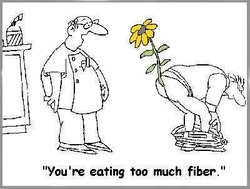 Fiber. It’s one of those nutrients we often hear about, but did you know that most Americans are deficient in it? Public health guidelines from the US Food and Drug Administration (FDA) advise Americans to eat between 20 and 38 grams of fiber a day, but most adults don’t even eat half that much. This post will describe what fiber is, its fabulous health benefits and how we can ramp up our intake. (And I promise you won't grow a sunflower out of your bum!) Dietary fiber is basically the parts of plant foods that our bodies can't digest or absorb. It passes relatively intact through our stomach, small intestine, colon and out of our body. Fiber is present in all plants that are eaten for food, including fruits, vegetables, grains, beans, lentils and peas. Though there are many types of fiber, they are generally categorized as either “soluble” or "insoluble”. Soluble fiber dissolves in water to form a gel-like texture, helping to slow down your digestion and make you feel full. These fibers help lower cholesterol and help regulate blood sugar levels. Soluble fiber is found in oats, lentils, apples, oranges, pears, strawberries, nuts, flaxseeds, beans, dried peas, blueberries, psyllium, cucumbers, celery, and carrots. Insoluble fiber does not dissolve in water and adds bulk to your stool and speeds up the passage of food and waste through your gut, helping prevent constipation. It also helps regulate your intestine’s pH. It is found in whole grains such as whole wheat, barley, brown rice and bulgar, nuts and seeds, zucchini, celery, broccoli, cabbage, onions, tomatoes, carrots, cucumbers, green beans, dark leafy vegetables, raisins, grapes, and root vegetable skins. Most plant-based foods, such as oatmeal and beans, contain both soluble and insoluble fiber. However, the amount of each type varies in different plant foods. Eating a wide variety of fibers is the ideal solution to gaining all the health benefits. Benefits of a high-fiber diet:
Ways to boost your intake: We should get at least 20 grams of fiber a day, but more is better. Slowly adding more fiber to your diet can avoid bloating and gas by giving your body time to adapt. It is also important to drink plenty of liquids while increasing fiber.
4 Comments
8/28/2014 02:40:25 am
Andie, You are a terrific writer. But the info is terrific.
Reply
9/12/2020 08:21:21 am
This article posted at this website is actually good.
Reply
Leave a Reply. |
AuthorHello and welcome! My name is Andrea Notch Mayzeles. I am a Certified Health Education Specialist, Mom, and Master of Public Health dedicated to the path of well-being. As a wellness professional I am committed to continued learning and am here to share research, recipes and musings on health, psychology, personal development, and parenting. I hope you enjoy! Categories
All
|

 RSS Feed
RSS Feed